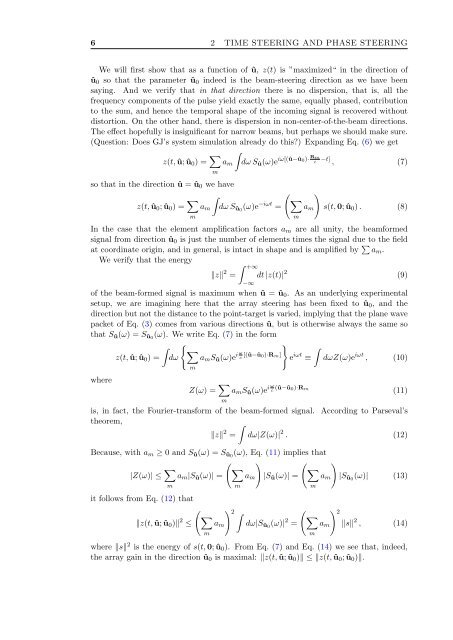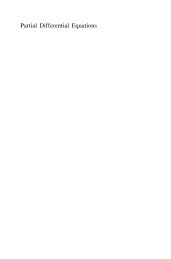a Matlab package for phased array beam shape inspection
a Matlab package for phased array beam shape inspection
a Matlab package for phased array beam shape inspection
Create successful ePaper yourself
Turn your PDF publications into a flip-book with our unique Google optimized e-Paper software.
6 2 TIME STEERING AND PHASE STEERING<br />
We will first show that as a function of û, z(t) is ”maximized“ in the direction of<br />
û 0 so that the parameter û 0 indeed is the <strong>beam</strong>-steering direction as we have been<br />
saying. And we verify that in that direction there is no dispersion, that is, all the<br />
frequency components of the pulse yield exactly the same, equally <strong>phased</strong>, contribution<br />
to the sum, and hence the temporal <strong>shape</strong> of the incoming signal is recovered without<br />
distortion. On the other hand, there is dispersion in non-center-of-the-<strong>beam</strong> directions.<br />
The effect hopefully is insignificant <strong>for</strong> narrow <strong>beam</strong>s, but perhaps we should make sure.<br />
(Question: Does GJ’s system simulation already do this?) Expanding Eq. (6) we get<br />
z(t, û; û 0 ) = ∑ ∫<br />
a m dω Sû(ω)e iω[(û−û 0)· Rm c −t] , (7)<br />
m<br />
so that in the direction û = û 0 we have<br />
z(t, û 0 ; û 0 ) = ∑ ∫<br />
( ∑<br />
a m dω Sû0 (ω)e −iωt =<br />
m<br />
m<br />
a m<br />
)<br />
s(t, 0; û 0 ) . (8)<br />
In the case that the element amplification factors a m are all unity, the <strong>beam</strong><strong>for</strong>med<br />
signal from direction û 0 is just the number of elements times the signal due to the field<br />
at coordinate origin, and in general, is intact in <strong>shape</strong> and is amplified by ∑ a m .<br />
We verify that the energy<br />
‖z‖ 2 =<br />
∫ +∞<br />
−∞<br />
dt |z(t)| 2 (9)<br />
of the <strong>beam</strong>-<strong>for</strong>med signal is maximum when û = û 0 . As an underlying experimental<br />
setup, we are imagining here that the <strong>array</strong> steering has been fixed to û 0 , and the<br />
direction but not the distance to the point-target is varied, implying that the plane wave<br />
packet of Eq. (3) comes from various directions û, but is otherwise always the same so<br />
that Sû(ω) = Sû0 (ω). We write Eq. (7) in the <strong>for</strong>m<br />
∫<br />
} ∫<br />
z(t, û; û 0 ) = dω a m Sû(ω)e i ω c [(û−û 0)·R m]<br />
e iωt ≡ dωZ(ω)e iωt , (10)<br />
{ ∑<br />
m<br />
where<br />
Z(ω) = ∑ m<br />
a m Sû(ω)e i ω c (û−û 0)·R m<br />
(11)<br />
is, in fact, the Fourier-trans<strong>for</strong>m of the <strong>beam</strong>-<strong>for</strong>med signal. According to Parseval’s<br />
theorem,<br />
∫<br />
‖z‖ 2 = dω|Z(ω)| 2 . (12)<br />
Because, with a m ≥ 0 and Sû(ω) = Sû0 (ω), Eq. (11) implies that<br />
|Z(ω)| ≤ ∑ ( ) ( )<br />
∑ ∑<br />
a m |Sû(ω)| = a m |Sû(ω)| = a m |Sû0 (ω)| (13)<br />
m<br />
m<br />
m<br />
it follows from Eq. (12) that<br />
‖z(t, û; û 0 )‖ 2 ≤<br />
( ∑<br />
m<br />
a m<br />
) 2 ∫<br />
dω|Sû0 (ω)| 2 =<br />
a m<br />
) 2<br />
‖s‖ 2 , (14)<br />
( ∑<br />
m<br />
where ‖s‖ 2 is the energy of s(t, 0; û 0 ). From Eq. (7) and Eq. (14) we see that, indeed,<br />
the <strong>array</strong> gain in the direction û 0 is maximal: ‖z(t, û; û 0 )‖ ≤ ‖z(t, û 0 ; û 0 )‖.
















